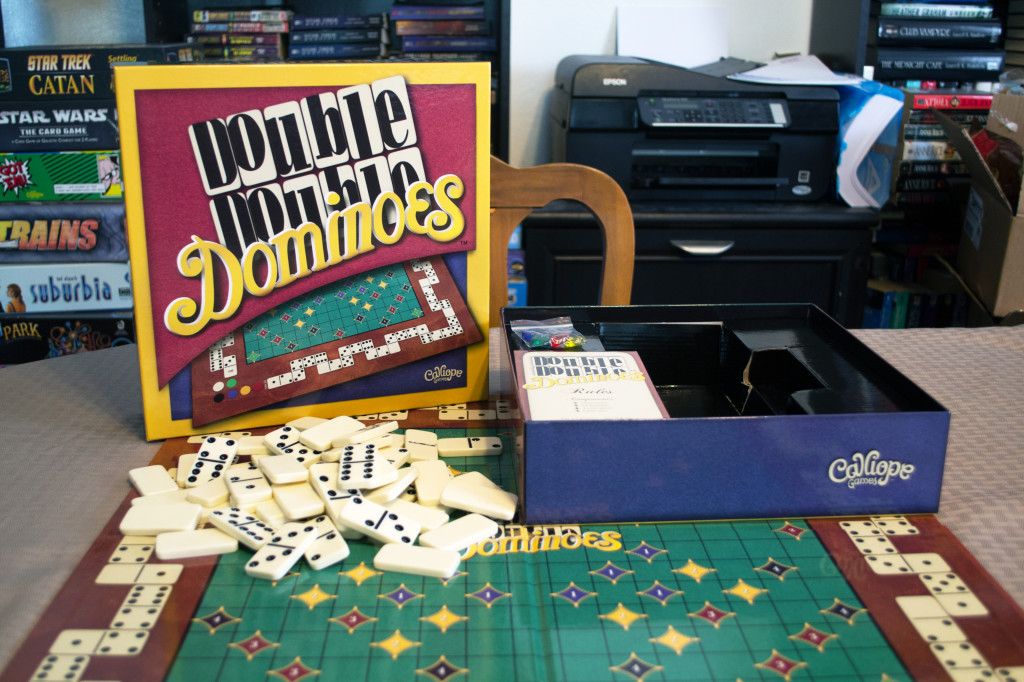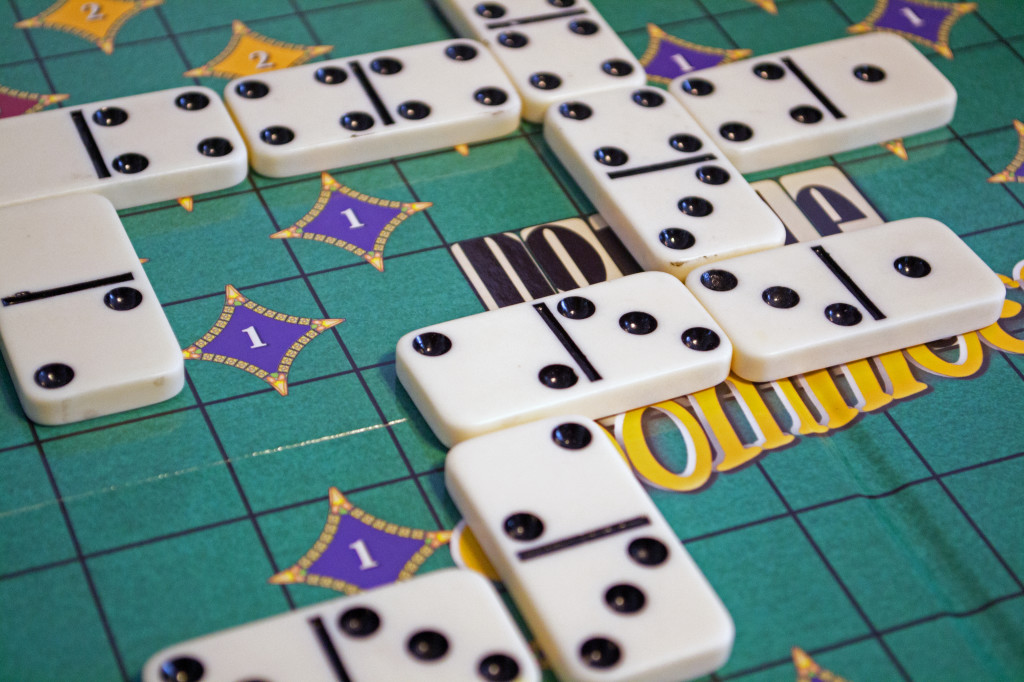Like “Scrabble”? How about “Dominoes”? If you said yes to either question, then you may want to pay attention as “Double Double Dominoes” is a blending of both games. Players will be tasked with placing their dominoes in “Domino” fashion on a game board reminiscent of “Scrabble”. Placing dominoes on point squares will net you a path up the victory point track, though you may also inadvertently cause your opponents to do the same…more on that later. Before we dive into this particular game, I’d like to thank both Ray Wehrs and Cassidy Werner from Calliope Games for providing me with a free press copy. Calliope Games are the same people who brought you “Tsuro“, “Tsuro of the Seas“, “Roll For It!“, “Got ‘Em!“, and “Ugh!“, for those of you who recognize the name.
Editor’s Note: The game’s manual lists an expansion that ups the player count to six, though I didn’t see an expansion being sold on the official website. After inquiring with Calliope Games, they informed me that an expansion is in the works. For now, “the game can be expanded with an additional set of double six dominoes and two additional pawn pieces.”
Components
Board – The middle of the playing board contains a “Scrabble-like” playing grid, complete with squares that award different amounts of points. The perimeter of the board lists a score track with each space containing a different value ranging from zero to six.
Dominoes – The game comes with fifty-six dominoes. These dominoes are two-sided…the face-up side contains two values (one on each end) while the face-down side is all blank. The values listed on the face-up side range from zero to six.
Score Tokens – There are four score tokens of different colors. Each player will choose one to call their own before the game begins.
Setup & Gameplay
The dominoes are mixed up and flipped face-down somewhere near the board, serving as a “draw pile” of sorts (called “The Boneyard”). Each player then takes three dominoes from this pile along with one scoring token, the latter of which is placed on their matching colored dot near the beginning of the score track. To determine who goes first, each player reveals their lowest valued domino (the one with the least total number of dots) and the person with the lowest number goes first. The players will keep these dominoes, placing them back into their respective “hands”.
On a player’s turn, they’ll observe the following actions:
1) Take a domino from the draw pile.
2) Place a domino onto the board. The very first domino must be placed on the center square. Playing a double domino (a domino with the same value on both ends) allows you to place another domino, but only if it can be played next to said double domino legally. I won’t get into specifics when it comes to legal domino placement, but suffice it to say that one end of the domino must touch an existing domino of the same value while the other end of the placed domino can touch nothing. The exception to that rule is if the other end is bridging a gap.
3) Score & move your token up the score track: one point = one space. A player can score by placing a domino piece onto a space containing a number. When they do, they score the value listed. A double domino earns them double the points. A player can also earn three bonus points when ANY player scores utilizing a domino that matches the value of the space of which your score token currently resides. If my score token was on a “5” space on the score track, for example, and someone placed a domino with five dots directly onto a score space, I’d score three bonus points.
Alternately, a player can draw and then discard a domino into a separate, permanent pile (called “The Pit”). A player may only do this when they have no legal plays available.
Play continues clockwise until a game ending condition occurs. The game ends immediately when a player reaches the designated victory point total (it changes depending on the number of players), in which case they win the game. It can also end if a player takes the last domino from the boneyard (in which case they play out their turn) or if there are no more spaces to which a domino can be played legally. The person with the highest score in these cases, wins!
The above doesn’t cover all of the rules found in the manual, but should give you a nice overview as to how the game is played. For more information, you can check out the rulebook here:
Double Double Dominoes Rulebook
The Review
Having never played “Dominoes” (yeah, weird huh?), I didn’t know what to expect. I actually took the time to Google how “Dominoes” was played to get an idea of the similarities and differences between it and “Double Double Dominoes”. From my understanding, players in “Dominoes” draw seven tiles and attempt to be the first to empty their hand. Domino placement seems to be consistent with what I’ve seen in “Double Double Dominoes”, though “Dominoes” is a bit more freeform as it doesn’t have a board. When a player goes out in “Dominoes”, they score points equal to the pips remaining in other players’ hands (sort of like in “Rummy”).
From my point of view, “Double Double Dominoes” expands on the original concept pretty well. Namely, it introduces different ways to score that also forces players to think about where they are placing their pieces. The biggest example would be with regard to how bonus points are scored…sure, you might be able to place a domino onto a score space, but SHOULD you? If the only scoring piece you have at your disposal will push your opponent ahead three spaces, it might behoove you to wait until your opponent is on a different space/value on the score track or until you draw a domino that can score you the points without helping out your opponent. I imagine I’d get pretty bored playing regular “Dominoes”, but the new mechanics that “Double Double Dominoes” introduces here almost guarantees that your game will be both strategic and interesting.
Determining a fair retail price was also a bit of a challenge. The official website lists the game for $30.00, while Amazon ranges between $17 and $27 (pricing/shipping costs depends on the individual shipper). The first thing I did was look up how much a regular case of similar dominoes was going for…again, the prices vary, but I found a set of 55 Cardinal Double Nine Color Dot Dominoes in a Color Collectors Tin for $8.99. I couldn’t tell you how much the board costs, but I’d imagine it would be somewhere around ten bucks in terms of value…it’s hard to say because the board is of pretty good quality. When you put it all together you have a twenty dollar game (estimated) officially priced at thirty. It’s worth noting that I am by no means a developer or have any experience in the business of making games, so there may be some hidden costs to which I’m not aware. My gut tells me however that the game’s price would sit better with me had it been between $20.00 and $25.00 (which seems to be the average retail price on Amazon).
In the end, “Double Double Dominoes” is both simple and engaging. I had no issues learning the rules, despite the fact that I had never played “Dominoes” before. Calliope Games has a habit of making solid, family friendly games and I’m pleased to report that they’ve done it again here. It’s easy to play yet still requires the user to think a bit, though not so much as to make you dread playing after coming home from a ten-hour workday. If you can get a good deal on it, “Double Double Dominoes” is worth picking up! Speaking of which, the folks at Calliope Games have once again graciously offered a 20% off coupon code for those who buy any game through their official website. That code is: DADSDOMINOES and is valid until August 31, 2014. It cannot be used with the other coupon codes mentioned in my “Ugh” and “Got ‘Em” reviews.
Final Verdict: 8/10
—
You can learn more about and purchase “Double Double Dominoes” by visiting the following websites:
http://www.calliopegames.com/
—



